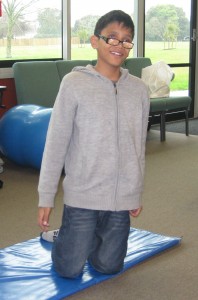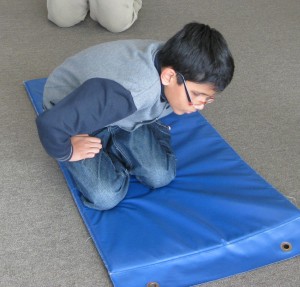Siddharth is 9 years and 6 months and has Retinopathy of Prematurity. He requires both physical assistance and verbal prompts to complete daily activites.
Sue Radford, his classroom teacher describes how the education team have worked collaboratively to support Siddharth as he develops his independent physical skills to perform daily tasks.
Siddharth is enrolled in the Homai Campus School and his education team work alongside Siddharth and his family to achieve his IEP goals: To practise movement skills and demonstrate the ability to link them in order to perform movement sequences.
In figure 1 Siddharth is kneeling with good posture.
Core strength and posture
Siddharth’s core strength and posture have improved significantly. He is more motivated to participate in activities and complete daily tasks in a timely manner.
In figure 2 Siddharth is moving from kneeling to the side without using his hands.
Siddharth can now go from side sitting to kneeling without using his hands to push himself up. He does need a verbal cue about not using his hands when performing a ‘controlled sit’ movement.
Prerequisite skills
Siddharth had low core strength which impacted on all physical activities of daily life, e.g. climbing in and out of the taxi, putting his school bag on and off, holding and sweeping with his cane and managing his workspace.
Siddharth required assistance and motivation to undertake all of these classroom tasks on a daily basis.
Figure 3 shows Siddharth using his hands to move from knees to side sitting. Siddharth is moving from kneeling to side sitting with the support of his hands. He finds that he needs to use his hands to support himself when doing this controlled movement.
Possible next steps
- Daily practice of exercise plan to continue building core strength.
- Siddharth will complete all school tasks independently.
Teaching methods and strategies
- Siddharth is highly motivated by competition with his peers. This was used as a motivator for him to complete exercises he found difficult to do.
- Daily class exercise sessions were part of his programme.
- He participated in the whole school Jump Jam session, daily class exercise sessions and weekly class PE lessons.
- Verbal prompting or encouragement were mainly used such as ‘Who can finish 5 bridges first’ or ‘Who can keep the particular stretch the longest’.
- Siddharth did not require physical prompts as he was positioned where he could watch as the teacher modelled what was expected.
Learning adaptations
- Siddharth’s individual physical programme was integrated into the whole class daily exercise programme. The decision was made to incorporate these into the daily routine as these exercises would be of benefit to all of the students in the class.
- All people working with Siddharth were required to give him time to complete daily activities on his own.
Assessment
After Siddharth had had a Full National Assessment the recommendations of the Physiotherapist were considered. The school physiotherapist set up an individual programme based on that information. She then reviewed the progress each term and adapted the programme accordingly.
Useful Links
- The National Curriculum: Health and physical education – Ministry of Education TKI website.
- Stepping Stones: The Expanded Core Curriculum – Blind and Low Vision Education Network NZ website.
- Orientation And Mobility (O&M): The Early Years Of Infancy Through Preschool – Texas School for the Blind and Visually Impaired website.
- Occupational Therapy and Sensory Integration for Visual Impairment – Texas School for the Blind and Visually Impaired website.
More information
Email us at BLENNZ for more information about this subject.
We will link you up with either the author of this post or another BLENNZ colleague with whom you can continue your conversation.



